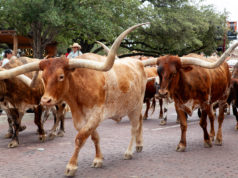Ain’t it sad how art becomes more beautiful over time, even with crackling and soiling, while humans just get … old. Bald heads and middle-aged spreads are a common sight at early Texas art shows and auctions. So what happens when these fogies are dead and gone? As George Jones (the hillbilly singer, not the British painter) said, “Who’s gonna fill their shoes?”
That question is on the minds of dealers trying to “create a younger market for the future,” said Bill Winter, a local art “peddler” — he doesn’t have a gallery or shop but finds and sells art to local collectors. Winter offered his comments earlier this month at the 5th Annual Early Texas Art Show and Sale in the Fort Worth Community Arts Center, where an impressive array of paintings covered the walls. The exhibition, put on by the Collectors of Fort Worth Art, has come a long way from its debut in a founding member’s backyard — not an ideal locale, since the typical customer was a baby-clothes-seeking garage-saler with little interest in Kelly Fearing, Dickson Reeder, and other Fort Worth artists whose early works are attracting more attention and higher prices these days.
The arts center has provided the perfect home for the annual show and sale since that shaky beginning, and attendance has risen along with the quality of art on the walls. If the show ever changes location, Winter said, “the spell will be broken.”
Twentysomethings often start out on the hunt for cutting-edge, abstract art by living artists, something big, colorful, provocative — and fairly cheap. They’re slow to buy academic works from earlier eras. After all, older paintings by trained and listed artists are an investment as intense as a real estate deal. Groups such as Collectors of Fort Worth Art, said Gregory Dow of Dow Art Galleries on Camp Bowie Boulevard, are spreading the word about early Texas artists to a new generation.
“I’d like to see a younger group come along that appreciates this type of art,” he said. “If you don’t bring it to people’s attention, it will be forgotten.”
Works by top artists, done between 1900 and 1960, are priced too high for many beginning collectors. Yet even a novice on a limited budget can assemble a memorable collection of early-20th-century art by focusing on obscure artists whose works are just beginning to garner interest among buyers. Dow said local visual artists who fall in that category include Dwight C. Holmes, Hedwyn Sanders, Josephine Mahaffey, and Thelma Park, among others. Dow and his father, Don Dow, are cataloging many of these names in a book he hopes to have published next year.
“You can still build a nice collection of art today without spending a fortune,” Dow said.
A skeptic might think attracting young collectors is simply a way for veterans to increase the value of their own investments, but it’s not that simple. Collectors and dealers tend to become passionate about the artists and the art’s historic implications. Broadening the market is a way of keeping alive that passion.
“We need somebody to take care of it after we’re gone,” Dow said. “It’s about appreciation, somebody who says, ‘I like this enough to want to own it.'”
A woman who taught many early artists their craft was Fort Worth’s Sallie Mummert, who from 1919 ’til her death in 1938 gave private instruction from her home on South Adams Street. Collectors of Fort Worth Art is presenting Sallie Mummert and Her Students, 1925-1945: An Exhibit of Early Fort Worth Art through July 31 at the arts center (1300 Gendy St). Take some advice — go see it. The large selection of Mummert originals gathered under one roof is unprecedented. Those works won’t be on sale, but if after touring the exhibit you get the bug, mosey on over to nearby Dow Art Galleries. They have a room dedicated to early Texas art for sale at reasonable prices.
You can reach Jeff Prince at jeff.prince@fwweekly.com.











